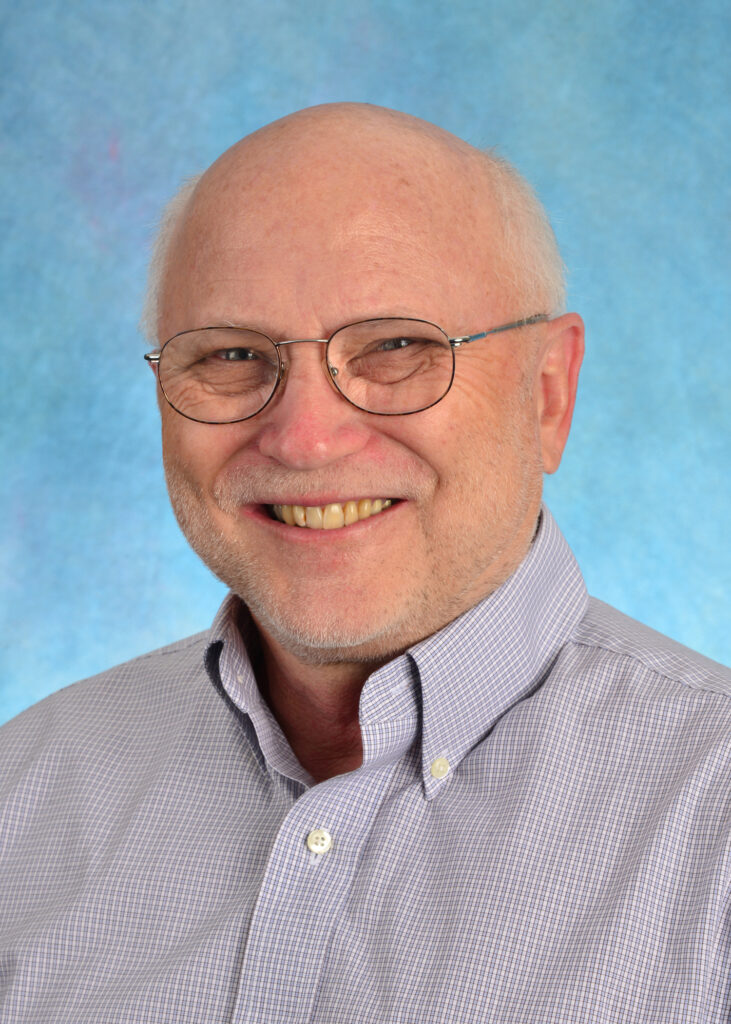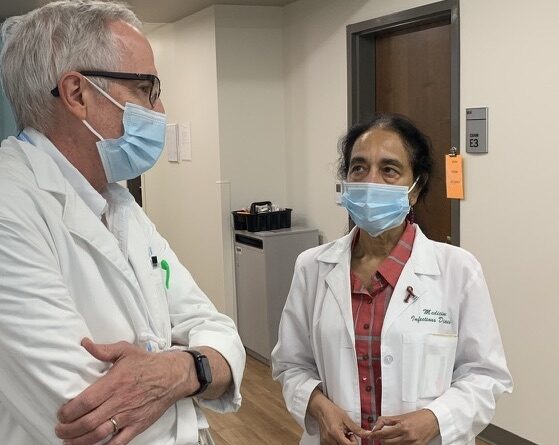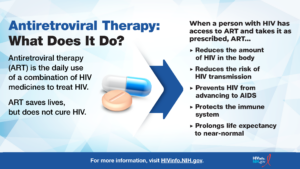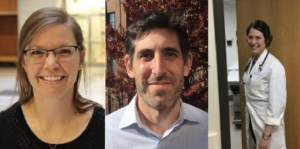The UNC Center for AIDS Research (CFAR) is an engine for funding HIV research, supported by a competitive NIH P30 infrastructure grant that has been successfully renewed since 1998. It is also a consortium of three complementary institutions (UNC, RTI and FHI) as CFAR Director Ron Swanstrom, PhD, and Associate Director Prema Menezes, PhD, PA-C, explain in the following Q & A. Affiliated with the Institute for Global Health and Infectious Diseases, the CFAR community is comprised of approximately 400 members who are passionate about a real-life response to AIDs. Members MacKenzie Cottrell, PharmD, and David Rosen, MD, PhD, describe this fierce research commitment, along with Claire Farel, MD, who directs UNC Health’s Infectious Diseases Clinic.

1) What is CFAR?
Swanstrom: “UNC CFAR is one of 19 NIH Centers for AIDS Research (CFAR) programs across the US that promote high quality AIDS research projects, providing administrative and shared support. It enhances and coordinates expertise, resources, and services, not otherwise readily obtained through more traditional funding mechanisms.
“Comprising UNC, the RTI and FHI 360, the consortium significantly adds to the breadth of HIV research. RTI is focused on both contract and grant-funded research, largely domestic but expanding into international work. FHI 360 has almost an exclusively international contract and research portfolio, along with an international service mission largely supported by USAID and charitable foundations. The complementary strengths of these institutions–combined with UNC’s strengths as a major research university with five health affairs schools: Medicine, Public Health, Dentistry, Pharmacy and Nursing–extend the reach of our activities and make our CFAR unique.”
2) How did UNC CFAR begin?

Swanstrom: “CFAR was a collaborative effort that started in 1998, initiated by Myron Cohen and myself, with support from Angela Kashuba, Joe Eron, and many others. Prema Menezes soon joined as Associate Director, and Ada Adimora as Co-Director. Others investigators came from RTI, Wendee Wechsberg, and from FHI, the late Ward Cates. Since then, CFAR has evolved and grown stronger, supported by FHI investigators Tim Maestro and Kate MacQueen. At RTI, Wendee Wechsberg has worked to increase our collaborations, which now includes Bill Zule and others.
Menezes: “Forming a consortium brought together complementary research interests to enhance the research potential at each institution. The UNC CFAR is one of the few CFARS successfully renewed without interruption. Our CFAR reached Tier 2 status in 2006 (1 of 4 CFARS to do this, with the University of Washington, UCSF and Harvard). The last renewal in 2020 received a perfect score of 10. This success reflects the highest level of research excellence and advancements in HIV.”
3) What does the UNC CFAR do?
Swanstrom: “When the NIH funds CFARs, they do so knowing this money could be used to fund more R01 grants. Thus, we have to add value to the overall research enterprise in a way that would be greater than just having a few more R01 grants. Over time, the NIH focus for HIV research has shifted and CFARs have to adapt to support these changing priorities. Ultimately, we have cores that support the NIH-funded HIV research of CFAR members, ideally expanding and enhancing those research efforts. The other charge of the CFAR is to cultivate the next generation of HIV researchers. We are always thinking about “early-stage investigators” and how we can support them with research funds (developmental awards and supplements), provide mentoring, and helping them showcase their work to the larger community, with some of these young people coming through our collaborations with international sites. In some of our work we find aspiring researchers, including from historically black colleges and universities, as undergrads or early grad students, to give them research opportunities in HIV.”

Menezes: “CFAR is an infrastructure grant that supports HIV research on campus. We have eight cores and through core services we facilitate cutting-edge research. The eight CFAR cores include: administrative, biostatistics, clinical, clinical pharmacological/analytical chemistry, developmental, HIV/STD laboratory, international and social and behavioral science. We also have a scientific working group–‘Carolinas United to End the HIV Epidemic’ that brings together researchers from North and South Carolina to work on ending the HIV epidemic activities.”
4) How does CFAR contribute to research on campus?
Swanstrom: “The structure of the CFAR is to support HIV research through its cores, which represent a wide range of expertise. But the CFAR does something else that is hard to put into a grant application but is invaluable. The CFAR helps create a community where people can expect to get help and also feel an obligation to provide help. It is a way of creating synergy with wonderful investigators. As part of the Administrative Core, we get to think about new research initiatives and research teams we can help put together. The special part of doing this is that we aren’t just telling someone ‘Oh, you should do this.’ We are saying we think you could be successful doing this, and we are going to be here to help. There are people throughout the CFAR who selflessly give of themselves, and I believe these collective efforts continuously seed this sense of what the CFAR is, going into the future.”
Menezes: “Part of CFAR’s mission is recruit the best talent to come to work at UNC, and continue to flourish within UNC. This is a shared collective effort between the CFAR and the various Health Science Schools on campus to identify and recruit the best talent consistent with CFAR and the hiring departments’ needs. CFAR’s other important role is to engage community voices and bring them to the table through our Office of Community Engagement, led by Dr. Ron Strauss.”
5) What do you enjoy about your work with CFAR?
Swanstrom: “The NIH provides CFARs with funding, and we get to use that funding to solve problems. We help buy equipment that can go into our cores where its use can be shared among investigators. We help young investigators at the critical time when they are getting their own independent research program started. We meet with faculty candidates during recruitment to describe the CFAR community. We put together new research teams. We work on community engagement to hear their interests and concerns and to inform them about our research community. We have enormous flexibility in what we can choose to do, it just has to be important to the goal of improving the lives of people with HIV and also ending the epidemic. I most also acknowledge how important it has been for me to work closely with Dr. Menezes, Dr. Adimora, and Dr. Cohen in our role as the Administrative Core. In addition, I have met so many remarkable people in other CFARs that became role models for me.”

Menezes: “I enjoy facilitating HIV research on campus because I can see the tangible benefits in patient care when I’m working in clinic. That connection between what we do in research, and how that actually benefits people and helps them live more healthy lives is something that I really treasure.”
6) How would you say CFAR has impacted patient care and in the clinic?
Swanstrom: “The goal of the CFAR is in the realm of research so we don’t directly support patient care. However, the CFAR has played an important role (through our Clinical Core) in bringing people who attend our clinic into the research enterprise. Engaging in research as a patient is dependent on a very special relationship between the care giver and the patient because the patient moves from being there to receive care to being a participant/partner in a research study. Remarkably, 98% of the people who attend our HIV clinic consent to being approached about participating in future research studies. It is their participation in research studies that drives new knowledge that can then impact improved patient care. Through this partnership in research the people who attend our clinic are central to our efforts to improve care and outcomes.”
Menezes: “Through the different CFAR cores we have provided critical services to multiple clinical studies that directly impact patient care, and it’s all integrated. Several of the studies that CFAR services facilitated have helped with the evolution of anti-retroviral treatment from protease inhibitors 20 years ago, to integrase inhibitors, and now, to long-acting injectable treatment. All of this is taking what we’ve learned in research and putting it into practice for the highest quality of patient care.”
7) Tell us about your day-to-day activities running CFAR
Swanstrom: “Every day we get to ask ourselves how can the CFAR help or have a positive impact on the work of our CFAR members. There are University and NIH requirements for administering a large research grant that can be tedious, but we never lose sight of how important the CFAR is to our community, which takes a little of the sting out of these tasks. We also live in a world of ideas and possibilities where we can try to use the CFAR and its resources to effect positive outcomes. The CFAR is full of committed researchers so we always welcome their requests for help, or their input of new ideas that really do come in daily.”
Menezes: “Running the CFAR covers the gamut from the mundane (ordering office supplies) to the sublime (novel breathtaking research). There are the annual reports that NIH needs, pre and post award compliance, personnel matters and all the things needed to keep the CFAR a well-oiled successful program. The thing I try to remember always is “service” and that my role is to always try to find a way to say ‘yes, we can help.’ ”
8) How can someone become a member of CFAR?
Swanstrom: “Our goal is to impact all HIV research. If that is an individual’s interest, then we welcome their engagement. Everyone is welcome to participate in our CFAR events, but to be eligible to apply for CFAR funding and use the cores, we have a few more restrictions.”
Menezes: “CFAR would not be what it is without our members, and we are deeply grateful for all of them. We welcome anyone to be part of the CFAR, but to become an associate member or a full member, there are a few more requirements. Those can be found at https://unccfar.org/membership/”

9) And what do members have to say about their research, supported by CFAR?
Cottrell: “I really love research in this area because rather than being somebody who’s taking the knowledge that other people are generating, and putting it together in a package to give to a patient at the pharmacy counter, I’m the person who is really on the foreground of generating knowledge and putting new information into the literature that others will then use and translate into patient care.”
Rosen: “CFAR research integrates prevention and care, and we believe there’s something intrinsically important about people having the ability to lead healthy lives. But it’s more than just those individuals. It also affects the families and communities that they returned to. We want to have people who are HIV infected to be as healthy as possible, not only for their own health, but to also reduce the possibility of transmission to others.”
Farel: “CFAR supports everything from laboratory science, to pharmacology, to clinical care to social and behavioral sciences. I think that diversity really shows its incredible strength in helping us treat all aspects of HIV…Obviously, a cure would be everybody’s happy ending and I think that promise is what keeps us all going.”
The Institute for Global Health & Infectious Diseases (IGHID) attracts people who are driven to make big change. From principal investigators and grant managers to regulatory specialists and study coordinators, everyone has an important role to play in what we do around the world. We are pleased to highlight the work of the people who proudly serve IGHID.
